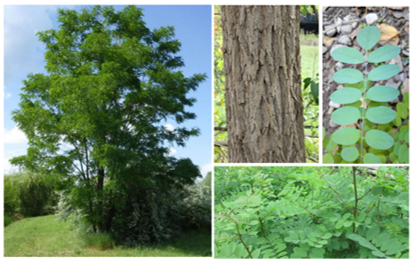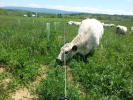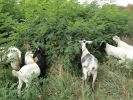| |
Hello Visitor,
Welcome to the Spring 2021 version of the Temperate Agroforester
We are trying a few new things here at the Temperate Agroforester. One of our new goals is to better reach out to producers in agoforestry and share their on-farm experiences, while also still providing new and exciting research. In our first attempt to reach this goal, we have chosen a theme and found producers and researchers willing to share their experiences and work. The theme for this version is black and honey locusts for silvopasture. We thank our farmers and researchers that contributed to this newsletter under the new format. If successful, we hope to continue this format throughout this year. The summer newsletter theme will be a recap of the North American Agroforestry Conference that will take place online from June 28 to July 2 (check out the article on NAAC 2021!). Our fall theme will be "marketing agroforestry products". We want to hear how producers are marketing their products: through farmers markets, online, in stores, or any innovative strategies, we want to hear about it! If you have an interest in submitting an article relevant to the theme or any questions, please submit your article topic or questions to afta_editor@aftaweb.org. We do welcome ideas for future themes and suggestions for articles, and, as always, we welcome any input or feedback about the newsletter at afta_editor@aftaweb.org.
Editor in chief, Christine Nieman and guest co-editor, John Fike
A shout out to locust trees
“What tree should I plant?” is one of the first questions that arises when folks begin entertaining ideas and thoughts of silvopastures and other agroforestry practices. We were in the same boat with this theme-based newsletter. The decision to use black locust and honey locust trees as our “lead off” species came from considerable interactions with producers who are using these trees to good effect in their farm operations. This focus also allows us to add an international perspective on the trees and to seek your support, which we’ll describe shortly.
For some readers, black locust and honey locust trees may be right “on point” for agroforestry systems, given their morphology, phenology, potential for N fixation, nectar production, and suite of uses as timber and browse. Other readers, perhaps not so fond of trees that have thorns and an ability to spread, may simply say “Why?”! Who better than those growing the trees to speak to that?
In this new newsletter you’ll find articles from producers in Missouri, New York, and Virginia that describe the diverse ecosystems and management approaches being taken to black locust and honey locust trees as part of silvopasture systems. In addition, you’ll find an article from Hungarian scientists working hard to breed better black locust trees for a number of uses. Our colleagues from Hungary have developed a number of black locust varietals for different end uses, and they are trying to understand the geographic origins of those trees. Read on through the newsletter to find out how you can assist their research efforts.
Guest co-editor John Fike, Professor, Virgina Ploytechnic Institute and State University
A call for help!
Our Hungarian colleagues are comparing the genetic makeup of black locust trees in relation to their geographic origin to help advance their breeding program. We are seeking your help to gather samples, spread the word, or both. Sampling and handling information follows. Please feel free to share this with friends, colleagues, conservationists, garden clubs, 4-H, or anyone who might be interested and willing to help. Many thanks for your help with this effort.
What to do:
1 - Identify a locust tree (see images below for several examples)
2 - Collect a tree leaf or two (as in the top right image)
2 - Record sampling site(s) (e.g., GPS coordinates or landmark e.g., mile marker "X" on "State Road YYY")
3 - Press sample(s) to dry (These can be placed in a note pad or an old phone book for a few days)
4 - Mail to John Fike (in a business envelope with regular postage) at the address below (and please include your name)
John Fike, Virginia Tech, 365 Smyth Hall, Blacksburg, VA 24061-0404

Events and Programs

Soil-To-Table Certification Program at Tres Estrellas Organic Farm and Garden Tecate, Baja California, Mexico
2021 Spring Course Dates – April 10 - May 22
Spend 6 weeks in the foothills of majestic Mount Cuchuma and learn about ecological farming, farm-to-table operations and self-reliance! Program includes hands-on and in classroom learning opportunities, field trips to nearby places of interest, shared housing, meals and two Saturdays at Rancho La Puerta Wellness Resort and Spa.
Program Cost: $1,500
For more information about this program and future programs (next program July 10 - August 21) contact Lindsey Hethcote at lhethcote@rancholapuerta.net
Membership
Are you interested in becoming a member of AFTA or need to renew? If so, get started clicking here. Your membership gives you access to the members-only area, discounts on conference registration, and helps support AFTA's mission to promote agroforestry.
Contents
Jacob Grace, Savanna Institute
 As many of us wait anxiously for in-person events to resume, the 2021 North American Agroforestry Conference (NAAC), “Scaling Up Agroforestry for Carbon Drawdown”, is moving forward as an online event scheduled for June 28th to July 2nd. This year’s conference, which is co-hosted by AFTA and the Savanna Institute, seeks to maintain a high level of networking and engagement while taking advantage of the opportunities provided by an online format.
Read More
Buck Holsinger, Holsinger Homeplace Farms, Virginia
 My 4 children, wife, and I returned to our 10th generation farm (circa 1773) in 2009 after my 1st overseas deployment with the Air National Guard. My Great-Grandfather was the last Holsinger to live on the property in the early 1970s, but the family continued to farm the property in the 70s, 80s, and 90s. Back then, the farm was part of a 70 head cow/calf operation, fenced as a single 72-acre tract, with cattle drinking from the ponds, stream, and house spring. We spent 2 weeks a year making tons of hay, and the rest of the year we fed that hay 2-3 days a week along with silage trucked from another farm 20 miles away.
That was then…This is now.
Read More
Klára Cseke and Zsolt Keserű, University of Sopron Forest Research Institute (SOE ERTI)
 Black locust (Robinia pseudoacacia L.) is one of the most important fast-growing, stand-forming tree species in Hungary, and its importance is increasing in many other countries. The species is indigenous to the eastern and central part of USA between latitudes 43o and 35o N. Black locust is good for wood production, honey production and ornamental purposes, with low incidence of pests and diseases. The promotion of black locust in Hungary, both in the past and in the present, was provoked by the following factors:1) the need to fix loose shifting sands; 2) demands for afforestation of abandoned agricultural lands; 3) abundant seed yield, vitality, excellent ability for sprouting and ability to fix free atmospheric nitrogen; 4) wide range of uses for black locust wood (tool manufacture, fuel wood, vineyard, poles and props, pit-wood, parquet); and 5) provision of flowers for bee forage.
Read More
Brett Chedzoy, Cornell Cooperative Extension
 In 1988, with a year of forestry school under my belt, I set about my goal of turning the 100 acres of fields on our family’s old dairy farm in upstate New York into forests. To my parents’ relief, I ran out of time to fully carry out the threat before heading off into the big world. However, several productive springs throughout college were enough to get trees started on 30 acres of the farm’s less productive fields.
On the better sites, we planted a mix of black locust and black walnut. My fledgling knowledge of forest economics showed it to be a great “get rich quick” scheme, which in forestry terms means in about 50 years. In hindsight, the brilliant part of that plan were the locusts. Sure, the walnuts are still there and someday we will reap what we have sown, but the locusts have been a blessing in multiple ways.
Read More
Joe Alley, NRCS State Forester Missouri and Robert Marsh, Floral Hill Farm Missouri
 Another locust to consider for your silvopasture is honey locust (Gleditsia triacanthos L). Robert Marsh in southwest Missouri has experimented with several types of trees but the primary species in his silvopasture is thornless honey locust.
Robert has been managing livestock on his farm, Floral Hill Farm in southwest Missouri, for over 30 years. Over these 30 years he has been experimenting with tree crops and silvopasture as ways to improve productivity and sustainability on his farm. Currently, his silvopasture encompasses a 20-acre bottom field, Huntington Silt-Loam, in which half of the 20 acres are prone to seasonal flooding. Robert raises Katahdin sheep and lamb is his primary market, but he also raises a few steers for friends and family.
Read More
|
|







